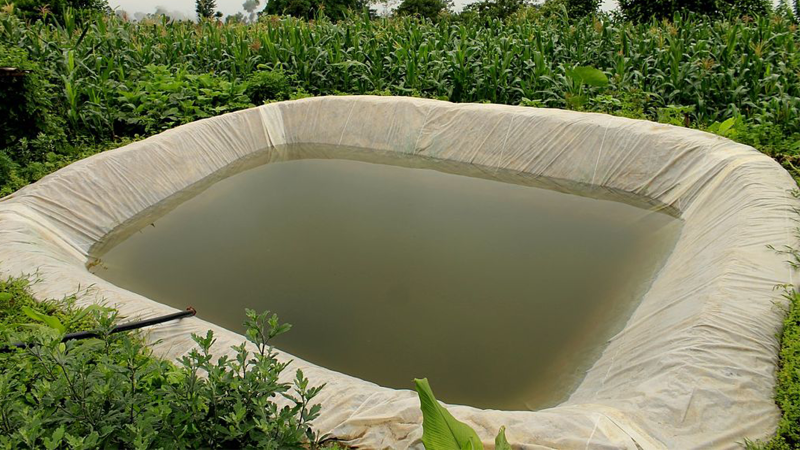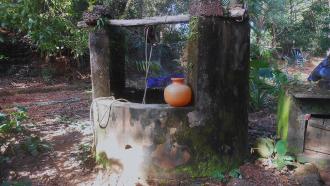
Image credits: Shree Krishna Dhital, CC BY-SA 3.0 , via Wikimedia Commons
Samuel Taylor Coleridge wrote “Water, water everywhere, Nor any drop to drink” in his 18th-century poem. Nowadays, those lines make perfect sense literally, as the world is grappling with diverse water scarcity scenarios.
Dryland agriculture contributes 68% of the cultivated area in India. Crop productivity, measured in the quantity of agricultural produce per unit of land area, is generally very low in drylands and semi-arid tropical areas. In India, these regions include landscapes in the states of Rajasthan, Gujarat, Haryana, parts of Uttar Pradesh, Central Maharashtra, Andhra Pradesh, Telangana, Karnataka and Tamil Nadu. Drylands experience an average annual rainfall of less than 750 mm, and crop production depends solely on rain. Semi-arid regions have unpredictable rainfall ranging between 400–1200 mm, and long dry seasons.
Adopting rainwater harvesting measures near and away from cultivable land is a very practical approach to mitigate drought and improve the groundwater level. It can facilitate crop intensification and agricultural production, leading to higher farm income. A report indicates a huge untapped potential for sustainable crop intensification in drylands and semi-arid tropics. However, the lack of adequate knowledge and quantifiable data on critical parameters such as rainfall, runoff water, soil loss and how they are related hinder the efficiency of rainwater harvesting measures.
In a recent study, researchers from the International Crops Research Institute for the Semi-Arid Tropics (ICRISAT) analysed 25 case studies of agricultural watersheds belonging to different rainfall regions in the semi-arid tropics of India. They identified potential zones for implementing rainwater harvesting interventions in Indian semi-arid zones.
The researchers conducted a meta-analysis—a statistical analysis combining the results of multiple scientific studies addressing the same question—on data collected by direct measurements from agricultural fields in different Indian states from 1996 to 2016. The fields belonged to a watershed area—areas from where the runoff water went into a lake or river. The team developed a rainfall-runoff-soil loss relationship by monitoring 25 case study data through field studies. They analysed the impact of rainwater harvesting measures by evaluating the runoff, groundwater levels, crop yields and net farm income.
Surface runoff refers to water flow on a ground surface when excess water from rain or other sources can no longer rapidly infiltrate the soil. It is a critical component in water balance studies. Water balance is determined by calculating the input, output and storage changes of water at the surface of that particular region.
Little is known about soil loss and surface runoff due to the lack of measured data. Hence the umpteen rainwater harvesting interventions in public welfare programmes remain futile due to the difficulty in assessing the impact of rainwater harvesting in the absence of data and corrective measures for refinements. To top it all, the water balance studies reported on semi-arid regions are either conducted for an entire river basin or on simulation modelling. Such data are not scalable to agricultural field studies for making community or landscape-based interventions.
The team installed meteorological stations in pilot watersheds and monitored runoff on 20–30 hectares of catchment area in 23 of the 25 intervention sites. They developed models from direct data to estimate surface runoff probabilities in an area of 128.4 million ha of Indian semi-arid regions.
Though the surface runoff varied with soil type and rainfall variability, average soil loss was 2 tons/hectare at a rainfall of 120 mm/ day. It was five folds higher at 10 tons/hectare as the rainfall intensity reached 250 mm/ day.
“About 200–300 mm of annual cumulative rainfall is the threshold to initiate surface runoff in the Indian semi-arid tropics,” says the lead author Dr Kaushal Garg.

Different methods of rainwater harvesting and the hydrological monitoring system set up in the study watersheds.
Credit: Garg, K.K. et al. (2022)
Though most of the farmers owned more than two hectares of land, the crop productivity of the 25 case study regions was 0.5 to 2 tonnes per hectare. Rainwater harvesting measures were carried out in the fields in an area of about 10% of the total landscape, and included making earthen bunds, raised beds and retention ditches. Such measures augment residual soil moisture, thereby minimising soil degradation. Creating 6–8 earthen bunds for 1–2 hectares of the land area reduced the intensity of flowing water. As the flow of water thus slowed down, it infiltrated into lower layers of soil, recharging groundwater tables and retaining soil moisture content.
Apart from rainwater harvesting arrangements in the fields, the team led by Dr Garg studied the measures adopted away from the fields. These measures were adopted in 40% of the total land area and included desilting and renovating traditional water bodies and farm ponds and constructing masonry check dams on a community basis. The researchers observed that about 10–500 hectares of the catchment area with a rainwater harvesting capacity of 5000–50000 m3 got benefitted. Such measures helped to avoid soil loss and improve groundwater tables in rural communities. The interventions had an outreach to 75 villages constituting an area of 29500 hectares, involving 9500 farming households. The whole effort created three million cubic metres of rainwater storage capacity.

Potential zones to undertake rainwater harvesting interventions in the semi-arid tropics of India.
Credit: Garg, K.K. et al. (2022)
The researchers used an average rainfall dataset between 1990 and 2018 for all the monitored semi-arid regions in the modeling studies. Southern states like Karnataka, Andhra Pradesh and Telangana received low rainfall and hence experienced low runoff and soil loss. Contrarily, watersheds in Uttar Pradesh and Madhya Pradesh receiving an annual rainfall of 800–1100 mm had high runoff loss and soil loss from 2–7 tons/hectare. Data analysis showed that Madhya Pradesh, Central Maharashtra, Telangana, Central & Eastern Andhra Pradesh and Uttar Pradesh have immense potential for rainwater harvesting as more than 70% of the semi-arid tropical area in these states creates runoff ranging from 150–250 mm. Harvesting a portion (40 mm) of runoff in these states helps improve agricultural productivity by 70% in those semi-arid regions.
“If the outflow (left out runoff after the interventions) is 50% less than the case where there is no rainwater harvesting, we considered it the low potential zone and mapped the zones accordingly,” added Dr Garg.
Hence states like Karnataka, parts of Maharashtra, western Andhra Pradesh, parts of Haryana & Punjab, and Rajasthan facing physical water scarcity have a low rainwater harvesting potential. However, the study did not analyse topographic factors like slopes or land use characteristics. Hence decisions regarding rainwater harvesting measure implementations need to be made carefully, based on the specificity of the site.
Rainwater harvesting improved groundwater availability, crop intensification (40–100%) and farmer’s income (50–200%) in monitored watersheds. Marginal harvesting of freshwater in years of moderate rainfall can improve the productivity of semi-arid ecosystems in India.
This article has been run past the researchers, whose work is covered, to ensure accuracy.






